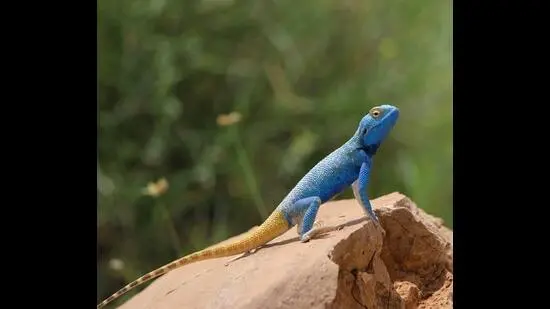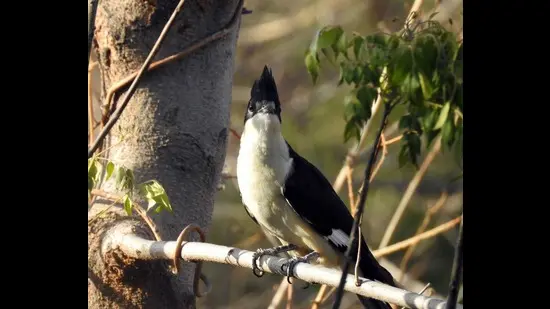
Only those as mad as a hatter would venture into the noon / afternoon heat of the Thar desert for a foodie binge. But for the Brilliant Ground agama (Trapelius / Agama agilis Olivier), a lesser known lizard and commonly confounded by locals with a girgit/korkirla (Garden lizard), the inferno of the desert is best suited for predation on insects and its own safety.
This is precisely the time, as the wise lizard knows, the avian hunters such as falcons, hawks and eagles will have beaten a retreat to a shady ‘thikana’. Insects, too, are active at this infernal time in the native flora of the Thar: Kheep, Ber, Jaal, Kumbat, Aak etc. Insects feed on foliage and lay eggs, and in turn are gobbled by the ‘lizards who duel at high noon’. The lizard is a burrowing species, with the female adapted to dig into the soil for nesting and protection while the male simply slithers under the Thar rocks.
“In summer, male lizards always stay in the open. As temperatures can rise to 55°C, male lizards also get affected by the heat but they counter the onslaught by changing into beautiful colours, which are known to be less absorbent of debilitating sun rays. To humans, it may appear that the lizard has turned magically into a gorgeous creature but the stark colouration changes are critical for survival. So, the head and abdomen changes from the standard dull brown, sandy colour into a vivid blue peppered with white spots while the tail turns yellowish-orange. The male’s entire lower surface turns white,” principal of the SBK Government PG College, Jaisalmer, Rajasthan, and professor of zoology, Shyam Sunder Meena, told this writer.
Meena was the first to venture into the field and study this neglected species of the Thar, resulting in a research paper: Sexual Selection and Sexual Dimorphism in Agama agilis. “To further cut down on heat absorption, male lizards alternatively move their legs up and down to minimise contact with the warm surface. They also select perches on foliage which are 6-9 feet above the hot earth,” Meena added.

The monsoons tail this cuckoo
The very early advent of the monsoons this year has manifested itself in avian form. The Pied or Jacobin cuckoo, which is partly a resident species as also a summer migrant from Africa, has been spotted pretty early. The cuckoo migrates to the northern regions of India to lay eggs surreptitiously in the nests of other birds, especially the Turdoides babblers. Cuckoo chicks are then reared by surrogate babbler parents in what is known as “brood parasitism”.
A very early record for Punjab came on May 24, 2025, when birder Manish Ahuja spotted a cuckoo on a power transmission wire just outside Ferozepur. This writer heard a cuckoo late at night the next day in Sector 19 A, Chandigarh. The earliest record for the cuckoo as far as the tricity is concerned is May 23, 2009, when this writer observed one at the 16th hole of the Shivalik Golf Club (SEPTA), Chandimandir.
Ebird India, which collates data on avian sightings, shows an unusual record. Samay Srivastava recorded a migrating cuckoo at the Jalvayu Towers Society, Gurugram, on May 1, 2025! Ebird also shows cuckoo records of May 18 and May 23, 2025, from Uttarakhand.
The migratory component of the cuckoos is adept at harnessing monsoon winds blowing from the Horn of Africa to migrate 1,500-2,000 km to the Indian coastline and then fly further inland. The pattern that seems to come across is that the monsoon winds come in from the south west but the rains spread southeast to northwest in India. The cuckoos come in with the winds but then spread over India with the rains, southeast to northwest.
Due to the cuckoo’s augury of the impending monsoon, the bird enjoys cultural resonance, including a reference in Kalidas’ Meghdoot as the ‘Chataka’: “(O cloud) the wind will be favourable, Slow and soft for thee and waft thee ahead, Close on thy left, The Chataka or the Rain lark, Will sing sweetly.”
